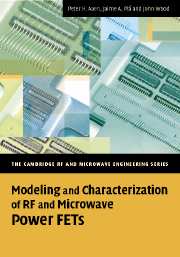Book contents
- Frontmatter
- Contents
- Preface
- Acknowledgments
- 1 RF and Microwave Power Transistors
- 2 Compact Modeling of High-Power FETs
- 3 Electrical Measurement Techniques
- 4 Passive Components: Simulation and Modeling
- 5 Thermal Characterization and Modeling
- 6 Modeling the Active Transistor
- 7 Function Approximation for Compact Modeling
- 8 Model Implementation in CAD Tools
- 9 Model Validation
- About the Authors
- Index
8 - Model Implementation in CAD Tools
Published online by Cambridge University Press: 19 August 2009
- Frontmatter
- Contents
- Preface
- Acknowledgments
- 1 RF and Microwave Power Transistors
- 2 Compact Modeling of High-Power FETs
- 3 Electrical Measurement Techniques
- 4 Passive Components: Simulation and Modeling
- 5 Thermal Characterization and Modeling
- 6 Modeling the Active Transistor
- 7 Function Approximation for Compact Modeling
- 8 Model Implementation in CAD Tools
- 9 Model Validation
- About the Authors
- Index
Summary
Introduction
The ultimate goal for a modeling engineer is to see the model that he has developed be used successfully by circuit designers in their CAD simulations of circuits and design of new products. All of the hard work in the characterization, construction, and mathematical analysis of the transistor to produce the compact model is only of value if it enables the circuit designer to be more confident in the design, and to produce better circuits. The design cycle is often speeded-up when better models are used. These goals and outcomes follow from the ‘Law of Simulation and Modeling’ that states: ‘a model is (mostly) useless unless it is embedded in a simulator.’ A successful model is one that is used, and is used in the design of successful products.
The implementation phase is therefore an essential element of any model development. The practical implementation in the CAD tool can take many forms, from an equivalent circuit composed of basic circuit elements already available in the simulator, to programming of the mathematical expressions in a high-level software language. To create a successful model, the modeling engineer needs to be involved in the detail of the implementation process: it is fully a part of the model development and deployment. The basic knowledge of how the simulator operates, its methods of solving the circuit equations and arriving at convergence, is invaluable in the implementation of a model that is accurate, fast, and easy to use.
- Type
- Chapter
- Information
- Modeling and Characterization of RF and Microwave Power FETs , pp. 297 - 322Publisher: Cambridge University PressPrint publication year: 2007

